Evaluation of Peri-Implantitis Bone Defect Healing: Comparing the Efficacy of Small-Particle Dentin and Bio-Oss in Bone Density Attenuation
Abstract
:1. Introduction
2. Materials and Methods
2.1. Patient Characteristics
2.2. Characteristics of the Materials Used
2.2.1. Fine-Particle Dentin
2.2.2. Bio-Oss
2.3. Material Implementation Procedure
2.4. Assessment of Radiographs and Assessment of Bone Attenuation
2.5. Statistical Analysis
3. Results
4. Discussion
5. Conclusions
Author Contributions
Funding
Institutional Review Board Statement
Informed Consent Statement
Data Availability Statement
Conflicts of Interest
References
- Jepsen, S.; Schwarz, F.; Cordaro, L.; Derks, J.; Hämmerle, C.H.F.; Heitz-Mayfield, L.J.; Hernández-Alfaro, F.; Meijer, H.J.A.; Naenni, N.; Ortiz-Vigón, A.; et al. Regeneration of alveolar ridge defects. J. Clin. Periodontol. 2019, 46, S82–S91. [Google Scholar]
- Castro, F.; Bouzidi, A.S.; Fernandes, J.C.H.; Bottino, M.C.; Fernandes, G.V.O. Bone tissue regeneration in peri-implantitis: A systematic review of randomized clinical trials. Saudi Dent. J. 2023, 35, 589–601. [Google Scholar] [CrossRef] [PubMed]
- Saska, S.; Mendes, L.S.; Gaspar, A.M.M.; Sidorenko de Oliveira Capote, T. Bone Substitute Materials in Implant Dentistry. In Bone Substitutes; IntechOpen: London, UK, 2015; pp. 1–20. [Google Scholar]
- Zhang, F.; Liu, G. Comparison of the clinical efficacy of bone grafting and bone grafting combined with guided tissue regeneration in periodontal regenerative therapy: A meta-analysis. Acta Odontol. Scand. 2024, 83, 166–173. [Google Scholar] [CrossRef]
- Bender, P.; Salvi, G.E.; Buser, D.; Sculean, A.; Bornstein, M.M. Correlation of Three-Dimensional Radiologic Data with Subsequent Treatment Approach in Patients with Peri-implantitis: A Retrospective Analysis. Int. J. Periodontics Restor. Dent. 2017, 37, 481–489. [Google Scholar] [CrossRef]
- Monje, A.; Pons, R.; Insua, A.; Nart, J.; Wang, H.L.; Schwarz, F. Morphology and severity of peri-implantitis bone defects. Clin. Implant. Dent. Relat. Res. 2019, 21, 635–643. [Google Scholar] [CrossRef]
- Corpas, L.S.; Jacobs, R.; Quirynen, M.; Huang, Y.; Naert, I.; Duyck, J. Peri-implant bone tissue assessment by comparing the outcome of intra-oral radiograph and cone beam computed tomography analyses to the histological standard. Clin. Oral Implant. Res. 2011, 22, 492–499. [Google Scholar] [CrossRef]
- Simón-Soro, A.; Mira, A. Solving the etiology of dental caries. Trends Microbiol. 2015, 23, 76–82. [Google Scholar] [CrossRef]
- Benítez-Páez, A.; Álvarez, M.; Belda-Ferre, P.; Rubido, S.; Mira, A.; Tomás, I. Detection of transient bacteraemia following dental extractions by 16S rDNA pyrosequencing: A pilot study. PLoS ONE 2013, 8, e57782. [Google Scholar] [CrossRef] [PubMed]
- Wawrzyk, A.; Łobacz, M.; Adamczuk, A.; Sofińska-Chmiel, W.; Rahnama, M. The Efficacy of a Diode Laser on Titanium Implants for the Reduction of Microorganisms That Cause Periimplantitis. Materials 2021, 14, 7215. [Google Scholar] [CrossRef]
- Ramanauskaite, A.; Becker, K.; Cafferata, E.A.; Schwarz, F. Clinical efficacy of guided bone regeneration in peri-implantitis defects. A network meta-analysis. Periodontol. 2000 2023, 93, 236–253. [Google Scholar] [CrossRef]
- Schwarz, F.; Sahm, N.; Becker, J. Combined surgical therapy of advanced peri-implantitis lesions with concomitant soft tissue volume augmentation. A case series. Clin. Oral Implant. Res. 2014, 25, 132–136. [Google Scholar] [CrossRef] [PubMed]
- Renvert, S.; Giovannoli, J.L.; Roos-Jansåker, A.M.; Rinke, S. Surgical treatment of peri-implantitis with or without a deproteinized bovine bone mineral and a native bilayer collagen membrane: A randomized clinical trial. J. Clin. Periodontol. 2021, 48, 1312–1321. [Google Scholar] [CrossRef] [PubMed]
- Berglundh, T.; Armitage, G.; Araujo, M.G.; Avila-Ortiz, G.; Blanco, J.; Camargo, P.M.; Chen, S.; Cochran, D.; Derks, J.; Figuero, E.; et al. Peri-implant diseases and conditions: Consensus report of workgroup 4 of the 2017 World Workshop on the Classification of Periodontal and Peri-Implant Diseases and Conditions. J. Clin. Periodontol. 2018, 45 (Suppl. 20), S286–S291. [Google Scholar] [CrossRef] [PubMed]
- Roccuzzo, M.; Pittoni, D.; Roccuzzo, A.; Charrier, L.; Dalmasso, P. Surgical treatment of peri-implantitis intrabony lesions by means of deproteinized bovine bone mineral with 10% collagen: 7-year-results. Clin. Oral Implant. Res. 2017, 28, 1577–1583. [Google Scholar] [CrossRef]
- Heitz-Mayfield, L.J.A.; Salvi, G.E.; Mombelli, A.; Faddy, M.; Lang, N.P. Anti-infective surgical therapy of peri-implantitis. A 12-month prospective clinical study. Clin. Oral Implant. Res. 2012, 23, 205–210. [Google Scholar] [CrossRef]
- Polymeri, A.; Anssari-Moin, D.; van der Horst, J.; Wismeijer, D.; Laine, M.L.; Loos, B.G. Surgical treatment of peri-implantitis defects with two different xenograft granules: A randomized clinical pilot study. Clin. Oral Implant. Res. 2020, 31, 1047–1060. [Google Scholar] [CrossRef] [PubMed]
- Bartold, M.; Gronthos, S.; Haynes, D.; Ivanovski, S. Mesenchymal stem cells and biologic factors leading to bone formation. J. Clin. Periodontol. 2019, 46 (Suppl. 21), 12–32. [Google Scholar] [CrossRef]
- Saeed, K.W.; Gataa, I.S.; Garib, B.T. Fine calcified human dentin particles grafts in experimental bone defects in rabbit femur accelerate bone healing and maturation. Int. J. Dent. Sci. Res. 2015, 2, 8–13. [Google Scholar] [CrossRef]
- Zhang, R.; Ruangsawasdi, N.; Pumpaluk, P.; Yuan, Q.; Peng, Y.; Seriwatanachai, D. Bone regeneration property of tooth-derived bone substitute prepared chairside for periodontal bone defects: An experimental study. BMC Oral Health 2023, 23, 863. [Google Scholar] [CrossRef]
- Shen, J.; Fisher, D.M.; Yasabala, B.; Wong Riff, K.W.Y.; Podolsky, D.J. The First Alveolar Bone Graft Simulator. Plast. Reconstr. Surg. Glob. Open 2023, 11, e5363. [Google Scholar] [CrossRef]
- Li, T.; Zeng, X.; Zou, S.; Xu, Y.; Duan, P. Recent advances in horizontal alveolar bone regeneration. Biomed. Mater. 2023, 18, acd672. [Google Scholar] [CrossRef] [PubMed]
- Alkhudhairy, F.; Vohra, F.; Al-Kheraif, A.A.; Akram, Z. Comparison of clinical and radiographic peri-implant parameters among obese and non-obese patients: A 5-year study. Clin. Implant. Dent. Relat. Res. 2018, 20, 756–762. [Google Scholar] [CrossRef] [PubMed]
- Vaidya, S.; Ho, Y.L.; Hao, J.; Lang, N.P.; Mattheos, N. Evaluation of the influence exerted by different dental specialty backgrounds and measuring instrument reproducibility on esthetic aspects of maxillary implant-supported single crown. Clin. Oral Implant. Res. 2015, 26, 250–256. [Google Scholar] [CrossRef] [PubMed]
- Tamimi, F.M.; Torres, J.; Tresguerres, I.; Clemente, C.; López-Cabarcos, E.; Blanco, L.J. Bone augmentation in rabbit calvariae: Comparative study between Bio-Oss and a novel beta-TCP/DCPD granulate. J. Clin. Periodontol. 2006, 33, 922–928. [Google Scholar] [CrossRef]
- Lim, J.; Jun, S.H.; Tallarico, M.; Park, J.B.; Park, D.H.; Hwang, K.G.; Park, C.J. A Randomized Controlled Trial of Guided Bone Regeneration for Peri-Implant Dehiscence Defects with Two Anorganic Bovine Bone Materials Covered by Titanium Meshes. Materials 2022, 15, 5294. [Google Scholar] [CrossRef] [PubMed]
- Kim, Y.J.; Saiki, C.E.T.; Silva, K.; Massuda, C.K.M.; de Souza Faloni, A.P.; Braz-Silva, P.H.; Pallos, D.; Sendyk, W.R. Bone Formation in Grafts with Bio-Oss and Autogenous Bone at Different Proportions in Rabbit Calvaria. Int. J. Dent. 2020, 2020, 2494128. [Google Scholar] [CrossRef] [PubMed]
- Zhao, R.; Yang, R.; Cooper, P.R.; Khurshid, Z.; Shavandi, A.; Ratnayake, J. Bone Grafts and Substitutes in Dentistry: A Review of Current Trends and Developments. Molecules 2021, 26, 3007. [Google Scholar] [CrossRef]
- Buser, D.; Urban, I.; Monje, A.; Kunrath, M.F.; Dahlin, C. Guided bone regeneration in implant dentistry: Basic principle, progress over 35 years, and recent research activities. Periodontol. 2000 2023, 93, 9–25. [Google Scholar] [CrossRef]
- Fadili, A.; Halimi, A.; Benyahia, H.; Zaoui, F. Stereology volume analysis to evaluate teeth’s root using CBCT images. Rep. Med. Imaging 2018, 11, 31–39. [Google Scholar] [CrossRef]
- Martins, L.A.C.; Sarna-Boś, K.; Kalinowski, P.; Różyło-Kalinowska, I. Cone-beam Computed Tomography Density Measurement Repeatability in Hounsfield Units: A Preliminary Study. J. Stomatol. 2023, 76, 191–195. [Google Scholar] [CrossRef]
- Yadegari, A.; Safi, Y.; Shahbazi, S.; Yaghoutiazar, S.; Ghazizadeh Ahsaie, M. Assessment of CBCT gray value in different regions-of-interest and fields-of-view compared to Hounsfield unit. Dentomaxillofac Radiol. 2023, 52, 20230187. [Google Scholar] [CrossRef] [PubMed]
- Binderman, I.; Hallel, G.; Nardy, C.; Yaffe, A.; Sapoznikov, L. A novel procedure to process extracted teeth for immediate grafting of autogenous dentin. Int. Dent. Afr. Ed. 2014, 7, 56–63. [Google Scholar]
- Schwarz, F.; Rothamel, D.; Herten, M.; Wüstefeld, M.; Sager, M.; Ferrari, D.; Becker, J. Immunohistochemical characterization of guided bone regeneration at a dehiscence-type defect using different barrier membranes: An experimental study in dogs. Clin. Oral Implant. Res. 2008, 19, 402–415. [Google Scholar] [CrossRef] [PubMed]
- Brunello, G.; Zanotti, F.; Scortecci, G.; Sapoznikov, L.; Sivolella, S.; Zavan, B. Dentin Particulate for Bone Regeneration: An In Vitro Study. Int. J. Mol. Sci. 2022, 23, 9283. [Google Scholar] [CrossRef] [PubMed]
- Raghoebar, G.M.; Onclin, P.; Boven, G.C.; Vissink, A.; Meijer, H.J.A. Long-term effectiveness of maxillary sinus floor augmentation: A systematic review and meta-analysis. J. Clin. Periodontol. 2019, 46 (Suppl. 21), 307–318. [Google Scholar] [CrossRef] [PubMed]
- Troeltzsch, M.; Troeltzsch, M.; Kauffmann, P.; Gruber, R.; Brockmeyer, P.; Moser, N.; Rau, A.; Schliephake, H. Clinical efficacy of grafting materials in alveolar ridge augmentation: A systematic review. J. Craniomaxillofac Surg. 2016, 44, 1618–1629. [Google Scholar] [CrossRef] [PubMed]
- Shaheen, M.Y.; Basudan, A.M.; Niazy, A.A.; van den Beucken, J.J.J.P.; Jansen, J.A.; Alghamdi, H.S. Histological and Histomorphometric Analyses of Bone Regeneration in Osteoporotic Rats Using a Xenograft Material. Materials 2021, 14, 222. [Google Scholar] [CrossRef]
- Schou, S.; Holmstrup, P.; Jørgensen, T.; Skovgaard, L.T.; Stoltze, K.; Hjørting-Hansen, E.; Wenzel, A. Anorganic porous bovine-derived bone mineral (Bio-Oss) and ePTFE membrane in the treatment of peri-implantitis in cynomolgus monkeys. Clin. Oral Implant. Res. 2003, 14, 535–547. [Google Scholar] [CrossRef] [PubMed]
- Mordini, L.; Sun, N.; Chang, N.; De Guzman, J.P.; Generali, L.; Consolo, U. Peri-Implantitis Regenerative Therapy: A Review. Biology 2021, 10, 773. [Google Scholar] [CrossRef]
- Urban, I.A.; Montero, E.; Monje, A.; Sanz-Sánchez, I. Effectiveness of vertical ridge augmentation interventions: A systematic review and meta-analysis. J. Clin. Periodontol. 2019, 46 (Suppl. 21), 319–339. [Google Scholar] [CrossRef]
- Tsitoura, E.; Tucker, R.; Suvan, J.; Laurell, L.; Cortellini, P.; Tonetti, M. Baseline radiographic defect angle of the intrabony defect as a prognostic indicator in regenerative periodontal surgery with enamel matrix derivative. J. Clin. Periodontol. 2004, 31, 643–647. [Google Scholar] [CrossRef]
- Garaicoa, C.; Suarez, F.; Fu, J.H.; Chan, H.L.; Monje, A.; Galindo-Moreno, P.; Wang, H.L. Using Cone Beam Computed Tomography Angle for Predicting the Outcome of Horizontal Bone Augmentation. Clin. Implant. Dent. Relat. Res. 2015, 17, 717–723. [Google Scholar] [CrossRef]
- Lollobrigida, M.; Fortunato, L.; Lamazza, L.; Serafini, G.; De Biase, A. Reosseointegration after the surgical treatment of induced peri-implantitis: Systematic review on current evidence and translation from the animal to the human model. Minerva Stomatol. 2020, 69, 37–54. [Google Scholar] [CrossRef] [PubMed]
- Ramanauskaite, A.; Fretwurst, T.; Schwarz, F. Efficacy of alternative or adjunctive measures to conventional non-surgical and surgical treatment of peri-implant mucositis and peri-implantitis: A systematic review and meta-analysis. Int. J. Implant. Dent. 2021, 7, 112. [Google Scholar] [CrossRef]
- Wang, H.L.; Boyapati, L. “PASS” principles for predictable bone regeneration. Implant. Dent. 2006, 15, 8–17. [Google Scholar] [CrossRef]
- Susin, C.; Fiorini, T.; Lee, J.; De Stefano, J.A.; Dickinson, D.P.; Wikesjö, U.M. Wound healing following surgical and regenerative periodontal therapy. Periodontol. 2000 2015, 68, 83–98. [Google Scholar] [CrossRef] [PubMed]
- Sanz-Martín, I.; Cha, J.K.; Sanz-Sánchez, I.; Figuero, E.; Herrera, D.; Sanz, M. Changes in peri-implant soft tissue levels following surgical treatment of peri-implantitis: A systematic review and meta-analysis. Clin. Oral Implant. Res. 2021, 32 (Suppl. 21), 230–244. [Google Scholar] [CrossRef] [PubMed]
- Carlsen, A.; Gorst-Rasmussen, A.; Jensen, T. Donor site morbidity associated with autogenous bone harvesting from the ascending mandibular ramus. Implant. Dent. 2013, 22, 503–506. [Google Scholar] [CrossRef]
- Renvert, S.; Roos-Jansåker, A.M.; Persson, G.R. Surgical treatment of peri-implantitis lesions with or without the use of a bone substitute-a randomized clinical trial. J. Clin. Periodontol. 2018, 45, 1266–1274. [Google Scholar] [CrossRef]
- Derks, J.; Ortiz-Vigón, A.; Guerrero, A.; Donati, M.; Bressan, E.; Ghensi, P.; Schaller, D.; Tomasi, C.; Karlsson, K.; Abrahamsson, I.; et al. Reconstructive surgical therapy of peri-implantitis: A multicenter randomized controlled clinical trial. Clin. Oral Implant. Res. 2022, 33, 921–944. [Google Scholar] [CrossRef]
- Li, Z.B.; Li, K.; Du, M.; Ren, S.B.; Yu, Y. Surgical treatment of peri-implantitis with or without adjunctive graft material: A systematic review and meta-analysis of randomized controlled trials. Int. J. Oral Maxillofac Surg. 2023, 52, 107–117. [Google Scholar] [CrossRef] [PubMed]
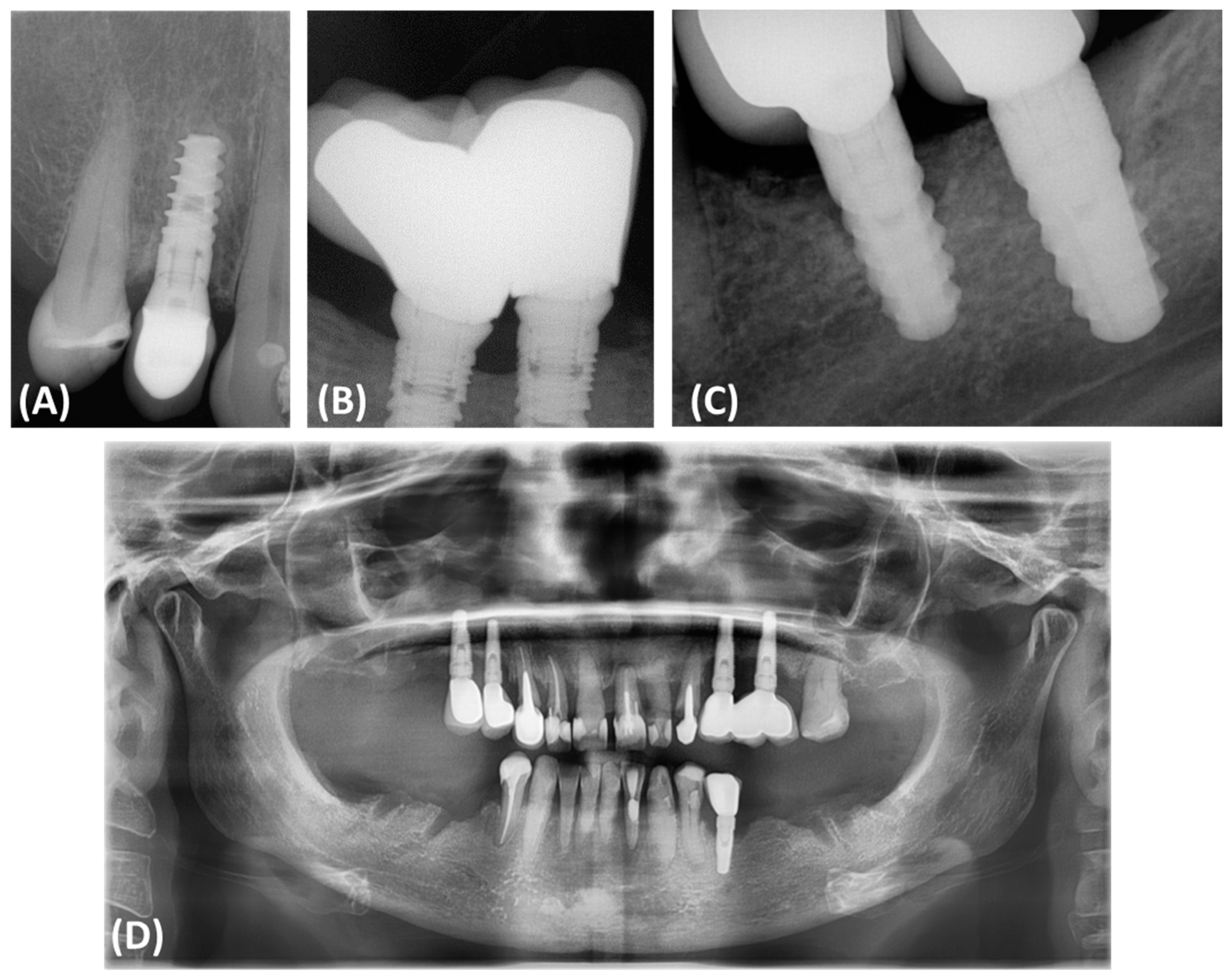
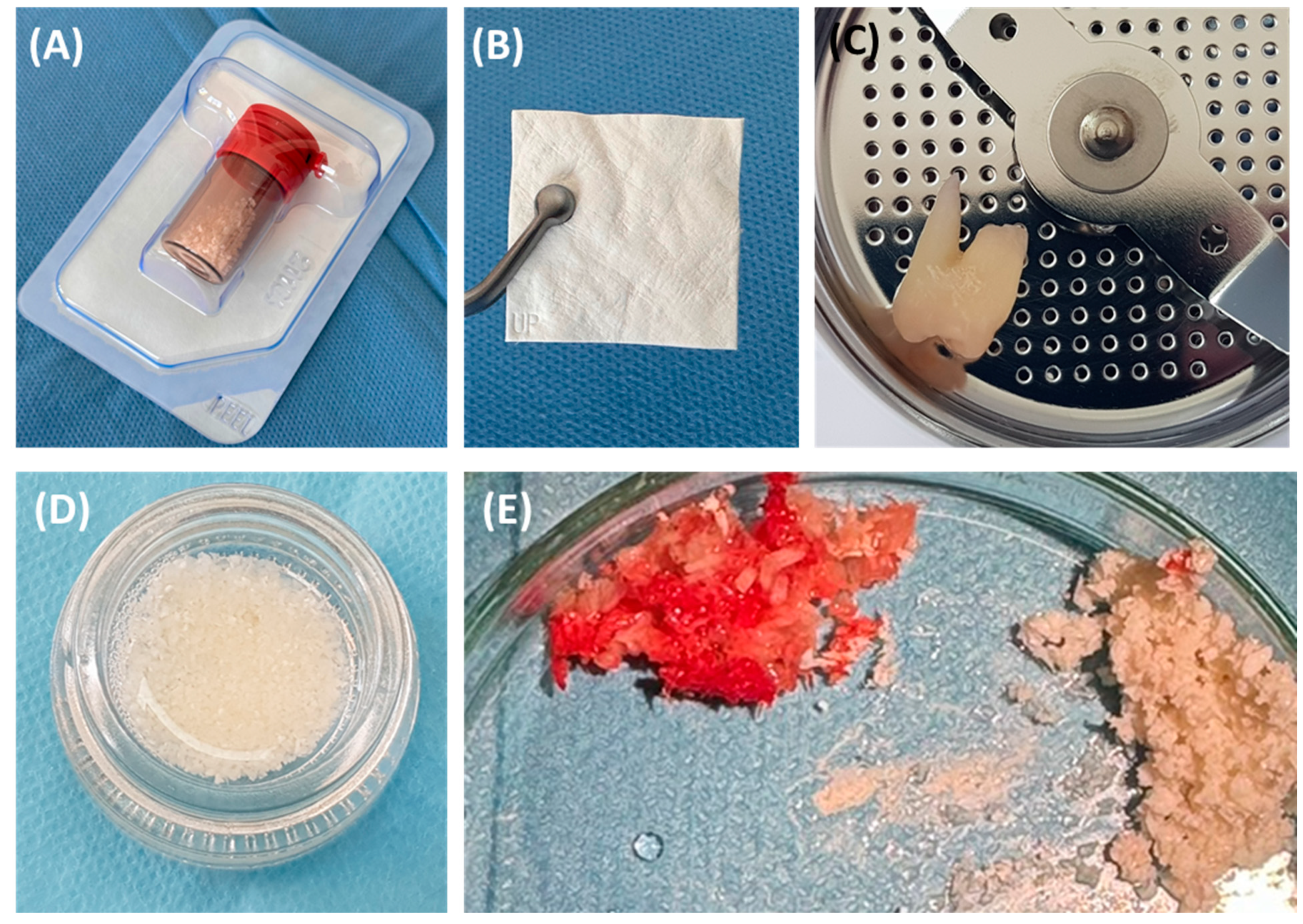
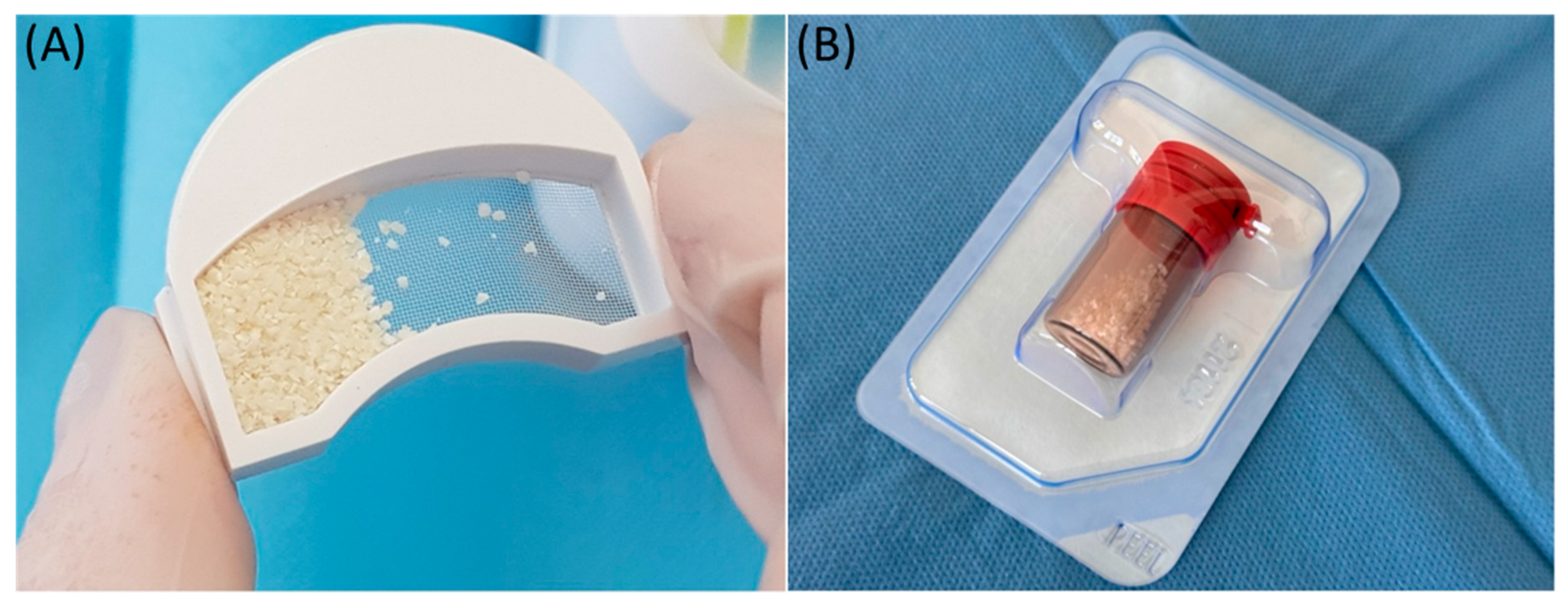
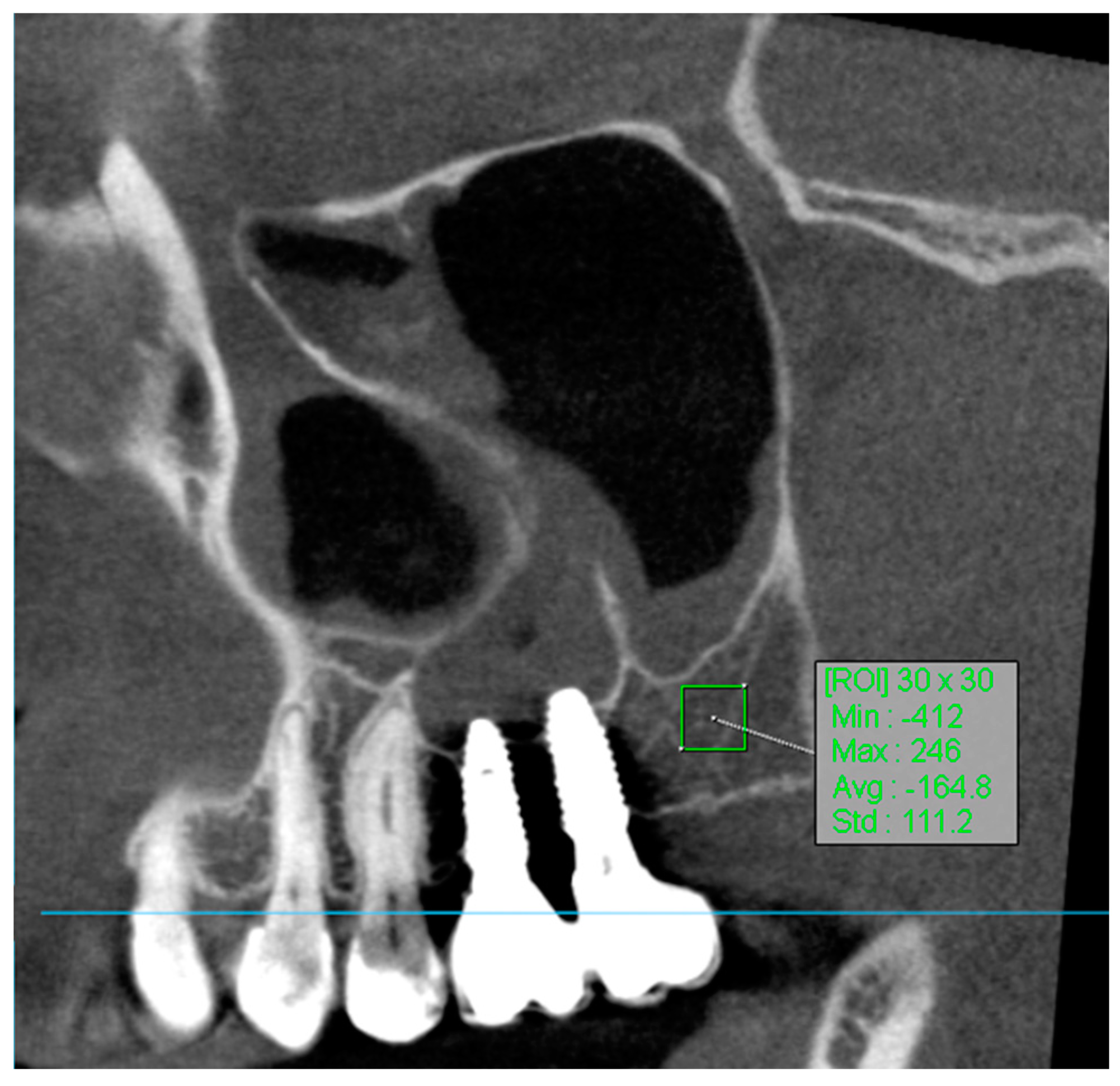
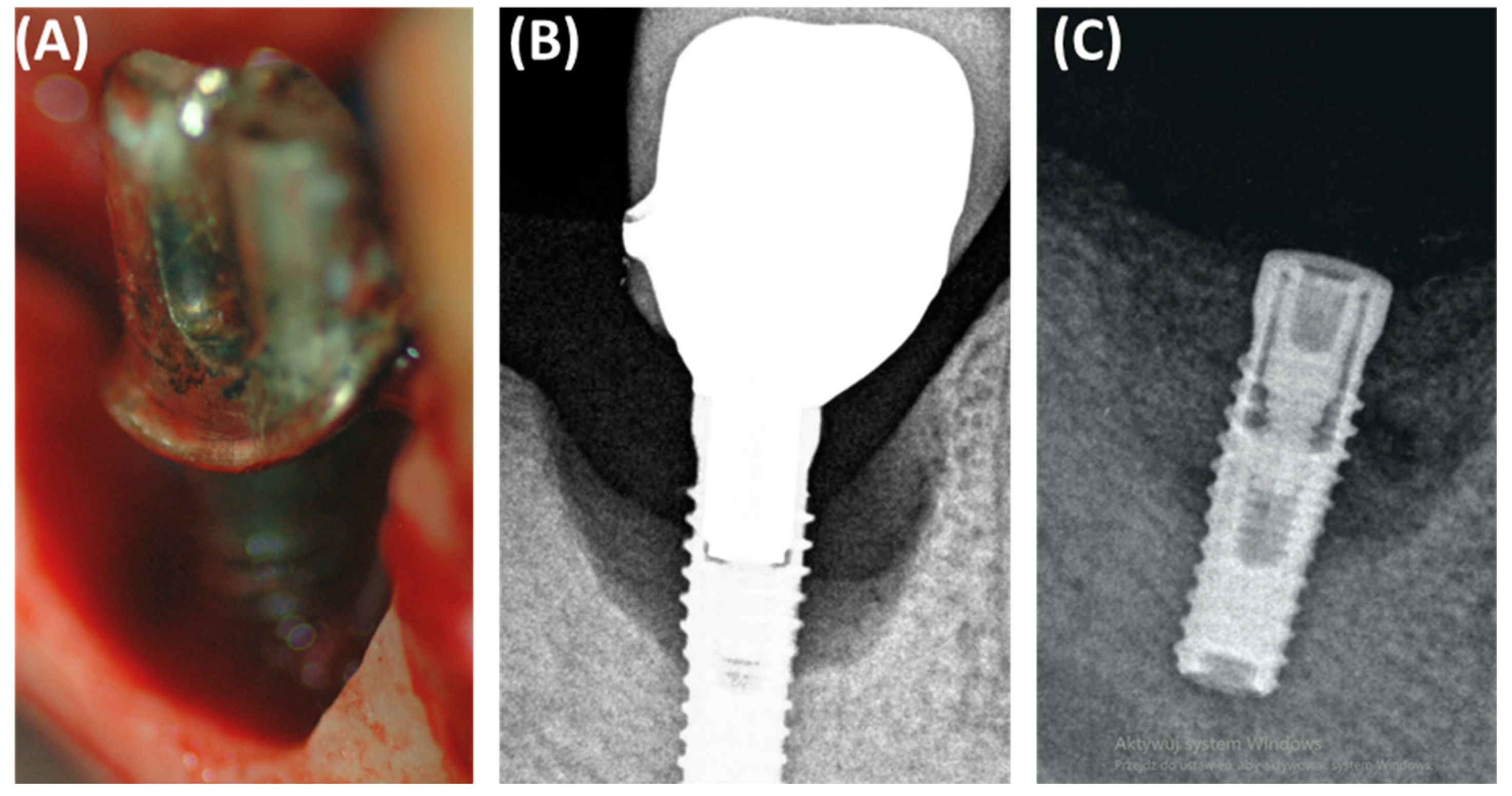
| Parameter | Small-Particle Dentin Group (Group 1) (HU) | Bio-Oss Group (Group 2) (HU) | Control Group (Group 3) (HU) | p-Value | |||
|---|---|---|---|---|---|---|---|
| Mean ± SD Median (Range) | Mean ± SD Median (Range) | Mean ± SD Median (Range) | 1 vs. 2 | 1 vs. 3 | 2 vs. 3 | ||
| Age | 27.91 ± 11.1 24 (18–58) | 40.27 ± 12.79 40 (19–60) | 29.15 ± 8.52 27 (16–58) | 0.002 * | 0.495 | 0.096 | |
| Bone attenuation | 779.62 ± 325.92 777.63 (185.16–1467.64) | 910.51 ± 155.03 936.37 (677.01–1140.91) | 206.04 ± 174.21 156.52 (14.73–672.74) | 0.652 | <0.001 * | <0.001 * | |
| Sex | Female | 15 (68.18%) | 8 (53.33%) | 16 (80.00%) | 1.000 | 1.000 | 0.278 |
| Male | 7 (31.82%) | 7 (46.67%) | 4 (20.00%) | ||||
| Anatomical area | Maxilla | 10 (45.45%) | 10 (66.67%) | 9 (45.00%) | 0.611 | 1.000 | 0.609 |
| Mandible | 12 (54.55%) | 5 (33.33%) | 11 (55.00%) | ||||
| Parameter | Small-Particle Dentin Group (Group 1) (HU) | Bio-Oss Group (Group 2) (HU) | Control Group (Group 3) (HU) | p-Value | |||||||
|---|---|---|---|---|---|---|---|---|---|---|---|
| Mean ± SD | Median (Range) | Mean ± SD | Median (Range) | Mean ± SD | Median (Range) | 1 vs. 2 | 1 vs. 3 | 2 vs. 3 | |||
| Mandible | Age | 26.42 ± 10.18 | 24 (18–58) | 52.60 ± 8.23 | 52 (40–60) | 29.18 ± 10.79 | 26 (16–58) | 0.003 * | 0.634 | 0.061 | |
| Bone attenuation | 736.07 ± 205.15 | 728.45 (472.41–1082.07) | 865.70 ± 173.86 | 758.83 (736.45–1140.91) | 235.05 ± 168.81 | 203.46 (42.86–672.74) | 1.000 | 0.001 * | 0.001 * | ||
| Sex | F | 9 (75.00%) | 3 (60.00%) | 9 (81.82%) | 1.000 | 1.000 | 1.000 | ||||
| M | 3 (25.00%) | 2 (40.00%) | 2 (18.18%) | ||||||||
| Maxilla | Age | 29.70 ± 12.42 | 24.5 (18–50) | 34.10 ± 9.88 | 33.5 (19–52) | 29.11 ± 5.18 | 28 (24–41) | 0.567 | 1.000 | 1.000 | |
| Bone attenuation | 831.89 ± 436.86 | 811.96 (185.16–1467.64) | 932.92 ± 149.26 | 978.61 (677.01–1108.53) | 170.59 ± 184.09 | 74.54 (14.73–607.06) | 1.000 | 0.003 * | 0.001 * | ||
| Sex | F | 6 (60.00%) | 5 (50.00%) | 7 (77.78%) | 1.000 | 1.000 | 0.630 | ||||
| M | 4 (40.00%) | 5 (50.00%) | 2 (22.22%) | ||||||||
| Parameter | Small-Particle Dentin Group (Group 1) (HU) | Bio-Oss Group (Group 2) (HU) | Control Group (Group 3) (HU) | p-Value | |||||||
|---|---|---|---|---|---|---|---|---|---|---|---|
| Mean ± SD | Median (Range) | Mean ± SD | Median (Range) | Mean ± SD | Median (Range) | 1 vs. 2 | 1 vs. 3 | 2 vs. 3 | |||
| Female | Age | 29.60 ± 12.11 | 24 (19–58) | 38.00 ± 15.51 | 37.5 (19–60) | 27.63 ± 8.74 | 26 (16–58) | 0.226 | 1.000 | 0.710 | |
| Bone attenuation | 689.17 ± 328.94 | 588.69 (185.16–1467.64) | 920.28 ± 132.96 | 915.35 (755.95–1140.91) | 229.67 ± 185.89 | 219.89 (42.86–672.74) | 0.354 | 0.002 * | <0.001 * | ||
| Anatomical area | Maxilla | 6 (40.00%) | 5 (62.50%) | 7 (43.75%) | 0.911 | 1.000 | 1.000 | ||||
| Mandible | 9 (60.00%) | 3 (37.50%) | 9 (56.25%) | ||||||||
| Male | Age | 24.29 ± 8.16 | 25 (18–41) | 42.86 ± 9.30 | 42 (31–52) | 35.25 ± 3.95 | 34 (32–41) | 0.008 * | 0.235 | 1.000 | |
| Bone attenuation | 973.45 ± 234.58 | 914.09 (696.44–1271.57) | 899.35 ± 187.56 | 936.37 (677.01–1108.53) | 111.54 ± 67.52 | 130.58 (14.73–170.27) | 1.000 | 0.010 * | 0.042 * | ||
| Anatomical area | Maxilla | 4 (57.14%) | 5 (71.43%) | 2 (50.00%) | 1.000 | 1.000 | 1.000 | ||||
| Mandible | 3 (42.86%) | 2 (28.57%) | 2 (50.00%) | ||||||||
| Bone Attenuation | Small-Particle Dentin Group (Group 1) (HU) | Bio-Oss Group (Group 2) (HU) | Control Group (Group 3) (HU) | p-Value | |||||
|---|---|---|---|---|---|---|---|---|---|
| Mean ± SD | Median (Range) | Mean ± SD | Median (Range) | Mean ± SD | Median (Range) | 1 vs. 2 | 1 vs. 3 | 2 vs. 3 | |
| At the studied site | 779.62 ± 325.92 | 777.63 (185.16–1467.64) | 910.51 ± 155.03 | 936.37 (677.01–1140.91) | 206.04 ± 174.21 | 156.52 (14.73–672.74) | 0.652 | <0.001 * | <0.001 * |
| In the adjacent site | 359.75 ± 195.10 | 378.00 (84.95–807.58) | 245.23 ± 155.29 | 207.29 (23.42–597.78) | 272.19 ± 153.06 | 289.30 (43.15–562.89) | 0.183 | 0.456 | 1.000 |
| Difference in density | 419.88 ± 317.60 | 346.99 (−116.32–1120.95) | 665.29 ± 142.31 | 687.37 (413.81–884.77) | −66.14 ± 203.62 | −43.45 (−490.11–288.83) | 0.072 | <0.001 * | <0.001 * |
| Patient Group | At the Studied Site (HU) | In the Adjacent Site (HU) | p-Value | ||
|---|---|---|---|---|---|
| Mean ± SD | Median (Range) | Mean ± SD | Median (Range) | ||
| Bio-Oss Group | 910.51 ± 155.03 | 936.37 (677.01–1140.91) | 245.23 ± 155.29 | 207.29 (23.42–597.78) | <0.001 * |
| Small-Particle Dentin Group | 779.62 ± 325.92 | 777.63 (185.16–1467.64) | 359.75 ± 195.10 | 378.00 (84.95–807.58) | <0.001 * |
| Control group | 206.04 ± 174.21 | 156.52 (14.73–672.74) | 272.19 ± 153.06 | 289.30 (43.15–562.89) | 0.163 |
| Bone Attenuation | Small-Particle Dentin Group (Group 1) (HU) | Bio-Oss Group (Group 2) (HU) | Control Group (Group 3) (HU) | p-Value | ||||||
|---|---|---|---|---|---|---|---|---|---|---|
| Mean ± SD | Median (Range) | Mean ± SD | Median (Range) | Mean ± SD | Median (Range) | 1 vs. 2 | 1 vs. 3 | 2 vs. 3 | ||
| Mandible | At the studied site | 736.07 ± 205.15 | 728.45 (472.41–1082.07) | 865.70 ± 173.86 | 758.83 (736.45–1140.91) | 235.05 ± 168.81 | 203.46 (42.86–672.74) | 1.000 | 0.001 * | 0.001 * |
| In the adjacent site | 319.51 ± 148.55 | 337.21 (107.53–562.89) | 245.42 ± 117.11 | 186.36 (184.40–453.54) | 293.36 ± 147.89 | 280.15 (98.96–562.89) | 1.000 | 1.000 | 1.000 | |
| Difference in density | 416.56 ± 132.12 | 364.88 (265.07–687.81) | 620.29 ± 77.37 | 572.47 (552.05–719.95) | −58.32 ± 168.64 | −43.06 (−319.72–207.01) | 0.317 | 0.002 | <0.001 * | |
| Maxilla | At the studied site | 831.89 ± 436.86 | 811.96 (185.16–1467.64) | 932.92 ± 149.26 | 978.61 (677.01–1108.53) | 170.59 ± 184.09 | 74.54 (14.73–607.06) | 1.000 | 0.003 * | 0.001 * |
| In the adjacent site | 408.03 ± 238.95 | 382.28 (84.95–807.58) | 245.13 ± 177.25 | 217.26 (23.42–597.78) | 246.30 ± 164.11 | 308.64 (43.15–562.89) | 0.278 | 0.329 | 1.000 | |
| Difference in density | 423.86 ± 462.60 | 192.01 (−116.32–1120.95) | 687.79 ± 164.79 | 752.60 (413.81–884.77) | −75.70 ± 250.46 | −52.69 (−490.11–288.83) | 0.468 | 0.055 | 0.001 * | |
| Patients Group | Anatomical Location | At the Studied Site (HU) | In the Adjacent Site (HU) | p-Value | ||
|---|---|---|---|---|---|---|
| Mean ± SD | Median (Range) | Mean ± SD | Median (Range) | |||
| Bio-Oss Group | Mandible | 865.70 ± 173.86 | 758.83 (736.45–1140.91) | 245.42 ± 117.11 | 186.36 (184.40–453.54) | <0.001 * |
| Maxilla | 932.92 ± 149.26 | 978.61 (677.01–1108.53) | 245.13 ± 177.25 | 217.26 (23.42–597.78) | <0.001 * | |
| Small-Particle Dentin Group | Mandible | 736.07 ± 205.15 | 728.45 (472.41–1082.07) | 319.51 ± 148.55 | 337.21 (107.53–562.89) | <0.001 * |
| Maxilla | 831.89 ± 436.86 | 811.96 (185.16–1467.64) | 408.03 ± 238.95 | 382.28 (84.95–807.58) | 0.018 * | |
| Control group | Mandible | 235.05 ± 168.81 | 203.46 (42.86–672.74) | 293.36 ± 147.89 | 280.15 (98.96–562.89) | 0.278 |
| Maxilla | 170.59 ± 184.09 | 74.54 (14.73–607.06) | 246.30 ± 164.11 | 308.64 (43.15–562.89) | 0.391 | |
| Bone Attenuation | Small-Particle Dentin Group (Group 1) (HU) | Bio-Oss Group (Group 2) (HU) | Control Group (Group 3) (HU) | p-Value | ||||||
|---|---|---|---|---|---|---|---|---|---|---|
| Mean ± SD | Median (Range) | Mean ± SD | Median (Range) | Mean ± SD | Median (Range) | 1 vs. 2 | 1 vs. 3 | 2 vs. 3 | ||
| Female | At the studied site | 689.17 ± 328.94 | 588.69 (185.16–1467.64) | 920.28 ± 132.96 | 915.35 (755.95–1140.91) | 229.67 ± 185.89 | 219.89 (42.86–672.74) | 0.354 | 0.002 * | <0.001 * |
| In the adjacent site | 330.37 ± 175.92 | 358.11 (84.95–674.57) | 232.70 ± 163.65 | 187.24 (23.42–498.26) | 265.75 ± 162.12 | 271.19 (43.15–562.89) | 0.480 | 0.884 | 1.000 | |
| Difference in density | 322.28 (−116.32–1109.53) | 358.80 ± 293.47 | 687.59 ± 123.97 | 704.54 (511.65–834.25) | −36.08 ± 210.62 | −14.04 (−490.11–288.83) | 0.104 | 0.004 * | <0.001 * | |
| Male | At the studied site | 973.45 ± 234.58 | 914.09 (696.44–1271.57) | 899.35 ± 187.56 | 936.37 (677.01–1108.53) | 111.54 ± 67.52 | 130.58 (14.73–170.27) | 1.000 | 0.010 * | 0.042 * |
| In the adjacent site | 422.70 ± 232.87 | 431.37 (150.62–807.58) | 259.55 ± 156.76 | 216.42 (110.16–597.78) | 297.94 ± 125.89 | 317.21 (127.16–430.18) | 0.440 | 1.000 | 1.000 | |
| Difference in density | 550.75 ± 350.40 | 438.87 (228.52–1120.95) | 639.80 ± 167.05 | 602.04 (413.81–884.77) | −186.40 ± 129.09 | −223.52 (−293.91–−4.65) | 1.000 | 0.053 | 0.008 * | |
| Patient Group | Anatomical Location | At the Studied Site (HU) | In the Adjacent Site (HU) | p-Value | ||
|---|---|---|---|---|---|---|
| Mean ± SD | Median (Range) | Mean ± SD | Median (Range) | |||
| Bio-Oss Group | Female | 920.28 ± 132.96 | 915.35 (755.95–1140.91) | 232.70 ± 163.65 | 187.24 (23.42–498.26) | <0.001 * |
| Male | 899.35 ± 187.56 | 936.37 (677.01–1108.53) | 259.55 ± 156.76 | 216.42 (110.16–597.78) | <0.001 * | |
| Small-Particle Dentin Group | Female | 689.17 ± 328.94 | 588.69 (185.16–1467.64) | 330.37 ± 175.92 | 358.11 (84.95–674.57) | 0.504 |
| Male | 973.45 ± 234.58 | 914.09 (696.44–1271.57) | 422.70 ± 232.87 | 431.37 (150.62–807.58) | 0.063 | |
| Control group | Female | 229.67 ± 185.89 | 219.89 (42.86–672.74) | 265.75 ± 162.12 | 271.19 (43.15–562.89) | <0.001 * |
| Male | 111.54 ± 67.52 | 130.58 (14.73–170.27) | 297.94 ± 125.89 | 317.21 (127.16–430.18) | 0.006 * | |
Disclaimer/Publisher’s Note: The statements, opinions and data contained in all publications are solely those of the individual author(s) and contributor(s) and not of MDPI and/or the editor(s). MDPI and/or the editor(s) disclaim responsibility for any injury to people or property resulting from any ideas, methods, instructions or products referred to in the content. |
© 2024 by the authors. Licensee MDPI, Basel, Switzerland. This article is an open access article distributed under the terms and conditions of the Creative Commons Attribution (CC BY) license (https://creativecommons.org/licenses/by/4.0/).
Share and Cite
Łobacz, M.; Wieczorek, K.; Mertowska, P.; Mertowski, S.; Kos, M.; Grywalska, E.; Hajduk, G.; Rahnama-Hezavah, M. Evaluation of Peri-Implantitis Bone Defect Healing: Comparing the Efficacy of Small-Particle Dentin and Bio-Oss in Bone Density Attenuation. J. Clin. Med. 2024, 13, 4638. https://doi.org/10.3390/jcm13164638
Łobacz M, Wieczorek K, Mertowska P, Mertowski S, Kos M, Grywalska E, Hajduk G, Rahnama-Hezavah M. Evaluation of Peri-Implantitis Bone Defect Healing: Comparing the Efficacy of Small-Particle Dentin and Bio-Oss in Bone Density Attenuation. Journal of Clinical Medicine. 2024; 13(16):4638. https://doi.org/10.3390/jcm13164638
Chicago/Turabian StyleŁobacz, Michał, Katarzyna Wieczorek, Paulina Mertowska, Sebastian Mertowski, Marek Kos, Ewelina Grywalska, Grzegorz Hajduk, and Mansur Rahnama-Hezavah. 2024. "Evaluation of Peri-Implantitis Bone Defect Healing: Comparing the Efficacy of Small-Particle Dentin and Bio-Oss in Bone Density Attenuation" Journal of Clinical Medicine 13, no. 16: 4638. https://doi.org/10.3390/jcm13164638






